We analyzed and studied over 100 Elementor add-ons and looked through 2,227 widgets to better understand the Elementor add-ons market.
Specifically, we looked at the pricing, widget offering, license distributions, and other important data to give you a birds-eye view of the add-ons in the Elementor market.
This study revealed some pretty interesting insights and findings:
Key Findings
- The average number of widgets in an Elementor add-on is 47.
- Unlimited Elements for Elementor is the add-on offers 318 widgets making it the add-on with the most number of widgets.
- Essential Add-ons is the most installed free Elementor add-on with over 600,000 installs.
- Freemium add-ons are priced higher than paid add-ons.
- Paid add-ons dominate the Elementor market by 38.2%. Free add-ons come second with 34.3%.
- 76.1% of add-ons have a lifetime pricing plan while only 56.7% of add-ons have an annual pricing plan.
- Only 12.7% of add-ons provide templates in their plugin.
- The frequency of updates of free add-ons is once every 4.5 months. On the other hand, the free version of freemium add-ons is updated once every 1.7 months.
- On average, an Elementor add-on costs $26.4 annually for a single-site license.
The Average Number of Widgets In An Elementor Add-on Is 47
During our study, we found that the average number of widgets in an Elementor add-on is 47. We also found that freemium add-ons on average have 59.6 widgets.
Here’s a breakdown of the average number of widgets based on pricing:

Why do freemium add-ons have more widgets?
While it’s impossible to answer this based on data alone, it’s likely due to the fact that freemium add-ons have to offer widgets in their free and paid plans which increases their widget offering.
But we found that many freemium add-ons offer limited widgets in their free version compelling users to upgrade to their premium version.
What surprised me during the study was that some add-ons don’t even clearly state the widgets available in the free version of their plugin.

This often leads to confusion among users as they aren’t able to figure out the widgets available in the free version.
Key Takeaway: If you’re looking for an add-on with more widgets, freemium add-ons are a better choice. And if you want to use a free add-on, check their widget offering before installing it.
Only 12.7% Of Add-ons Offer Templates
We’ve seen many popular Elementor add-ons now offer templates along with widgets.
But it’s only a small percentage of plugins that do this. We found that only 12.7% of Elementor add-ons offer templates.

It’s important to note here that we didn’t include any plugins or add-ons that solely offer templates.
While popular add-ons offer templates, it’s hard to see other add-ons adopt this because of two main reasons:
- Templates add a lot of bloat in the add-on affecting the performance of the plugin.
- There are already many Elementor template marketplaces that offer great templates.
Key Takeaway: A very small percentage of add-ons offer templates in their plugin. Also, using add-ons that offer templates could add bloat to your website. It’s better to find templates on marketplaces and download them.
Unlimited Elements Is The Add-on With The Most Number Widgets
As I outlined, Unlimited Elements for Elementor has the highest number of widgets among all the add-ons we studied.
With 318 widgets, this add-on surpassed all the other add-ons by a huge mile in terms of widgets.
Though this doesn’t necessarily mean they have the most unique widgets.
What I discovered was that Unlimited Elements has multiple widgets for the same use case which was the reason why they have so many widgets.

As you can see, there are a lot of widgets with the same use case but different styles.
Other add-ons usually combine all the different styles of a widget into one.
Still, there are add-ons with over 100 widgets that are totally unique. Here are the top 10 add-ons that have the most number of widgets:

Key Takeaway: While clearly, there are add-ons that have an insanely high number of widgets, this doesn’t necessarily mean all the widgets are unique.
A lot of add-ons usually break down the different styles of a single widget into multiple widgets leading the user to believe that they have a lot of widgets.
Image Comparison Slider Is The Most Common Widget Among Add-ons
After looking through 2,227 widgets, we found that the Image Comparison Slider is the most commonly found widget among add-ons.
This widget was found in 32.3% of Elementor add-ons we analyzed.

The second most popular widget we found is the Posts widget. This widget was found in 31.3% of the add-ons we studied.
According to our data, these are the 10 most common widgets found in Elementor add-ons:

We also found a lot of add-ons offering different 3rd party form widgets. From these widgets, Contact Form 7 widget is the most popular in terms of 3rd party form widgets.
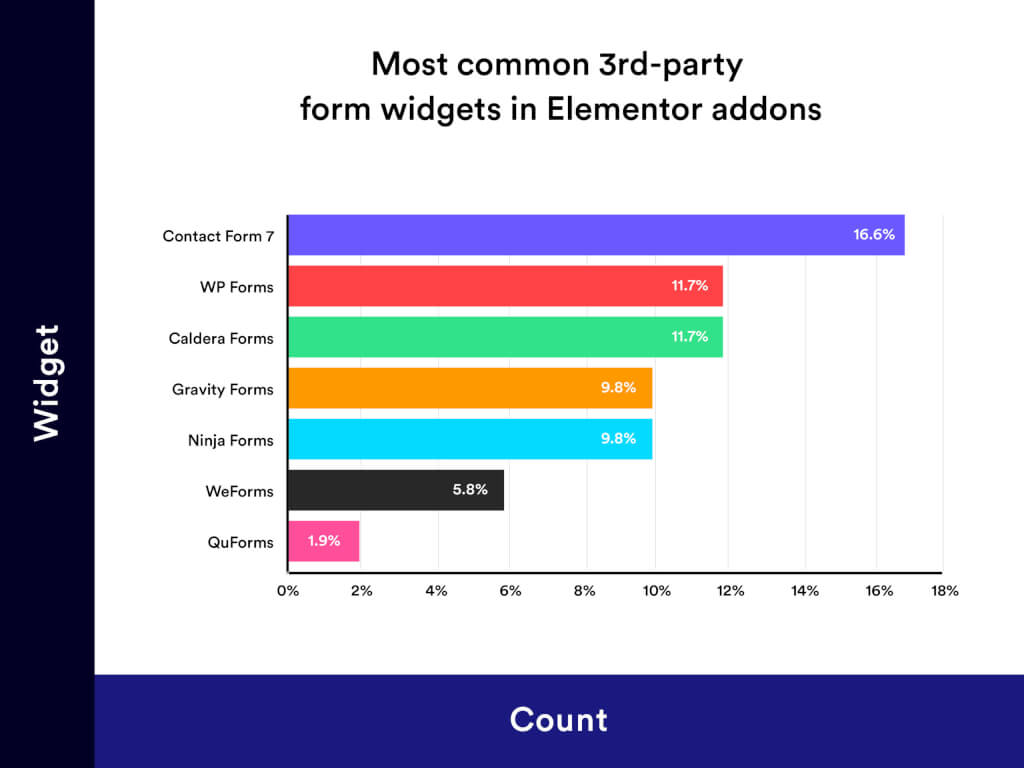
Key Takeaway: Image Comparison Slider is the most common widget among add-ons. 3rd-party form widgets are also popular among Elementor add-ons.
Only 45.2% Of Add-ons Provide Extended Features
Elementor add-ons today are not just about widgets. Many add-ons now offer features that extend the functionality of Elementor without adding any new widgets.
Features like particle effects, grid, cross-domain copy-paste fall into this category. We like to call them extended features.
In our study, we found that 45.2% of Elementor add-ons offer extended features. This clearly shows that add-ons are focused more on making Elementor better without introducing new widgets.

This is because a lot of Elementor users have complained about having too many widgets in add-ons.
Using an add-on with extended features can help avoid bloat that comes with so many widgets.

Our data found that Piotnet Addons for Elementor has the highest number of extended features. Here are the other add-ons with extended features:

Key Takeaway: If you’re tired of using add-ons with too many widgets, you can look for add-ons that offer extended features.
Parallax Effect Is The Most Common Extended Feature
What is the most popular extended feature?
According to our data, the Parallax effect is the popular extended feature.

Even though this feature is available in Elementor, many add-ons offer this by adding more functions and controls to extend the feature.
Besides this, other features such as Particles, Sticky Elements, Transform Effects are also popular.

There are many extended features that are not very common.
For example, the Widget Creator by Unlimited Elements is not available in any other add-on.
Similarly, Multi-Layer Gradients in our add-on Designer Powerup is not found in other add-ons.

Key Takeaway: Parallax is the most common extended feature among add-ons but there are many great features that are available only in some add-ons.
56.8% Of Add-ons Have Proper Documentation Available
Detailed documentation is important to help users get started with an add-on.
We found that 56.8% of add-ons have proper documentation available on their website.
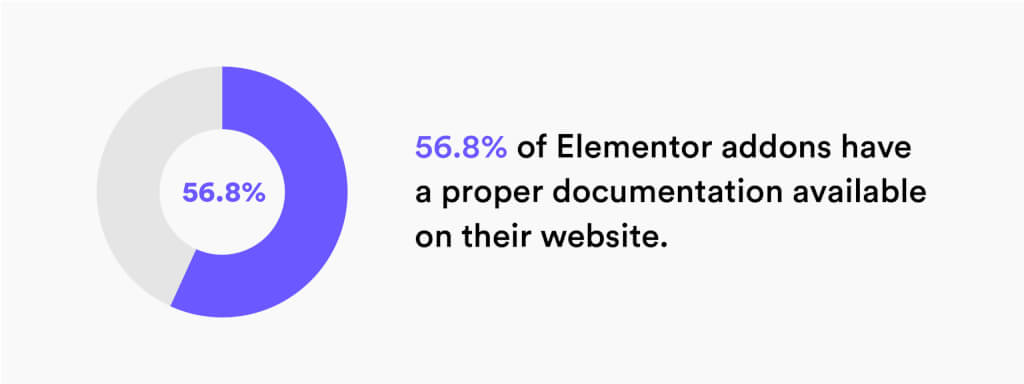
But we wanted to find if there is any correlation of documentation with the add-on’s business model.
Our data revealed that 28.4% add-ons that have documentation are paid while only 10.7% add-ons that have documentation are free.
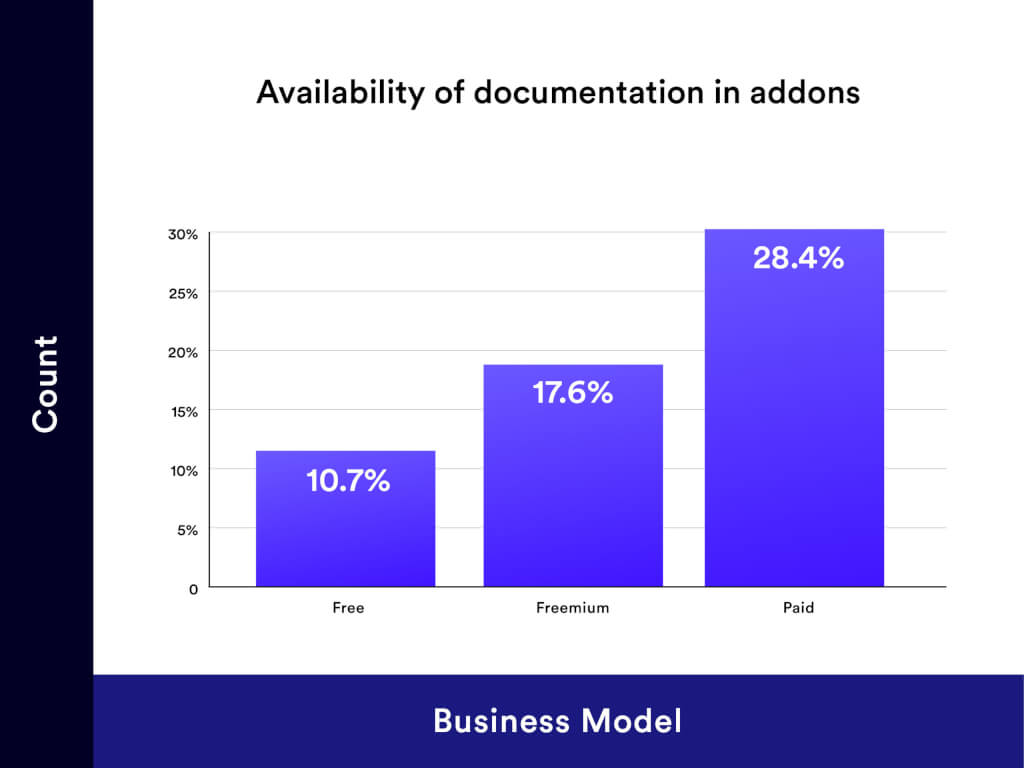
We further examined where freemium add-ons lie on the spectrum and found that 17.6% of add-ons that have proper documentation are freemium.
Key Takeaway: Paid add-ons are more likely to have proper detailed documentation compared to free and freemium add-ons.
42.1% Of Add-ons Have A Public Changelog
Besides documentation, changelogs are necessary to help users identify the changes and updates made to an add-on.
But only 42.1% of Elementor add-ons have a public changelog.
Out of this, 23.5% of add-ons that have changelogs are paid and only 3.9% of add-on plugins that have a changelog are free.

This is surprising since many WordPress plugins mention a changelog on their page in the repository. But such a low percentage of free Elementor add-ons have a public changelog.
Key Takeaway: Paid add-ons are more likely to have a public changelog available on their website compared to free or freemium add-ons.
The Average Installs For Free Elementor Add-ons Is 24,389
We found that the average number of installs for free Elementor add-ons is 24,389.
Here’s the distribution of installs of both free and freemium add-ons from the WordPress repository:

The freemium add-ons in WordPress have 59,212 installs on average.
This is because freemium add-on developers are more committed to their product and hence offer more features and regular updates.
According to our analysis, about 38% of free and freemium add-ons have installs in the range of 1000-5000.
Lastly, Essential Addons was the most installed Elementor add-on in our study with over 600,000 installs.

Key Takeaway: Freemium add-ons are installed more often from the WordPress repository than free add-ons.
Free Add-ons Are Not Updated Very Regularly
How often are free Elementor add-ons updated?
Our data suggest that the update frequency of free add-ons is 4.5 months. This means on average, a free Elementor add-on is updated once every 137 days.

As part of our analysis, we set out to answer: do freemium add-ons have the same update frequency?
Here’s what we found:
The update frequency of freemium add-ons is 1.7 months which is around 52 days.

Therefore when it comes to updates, freemium add-ons are better compared to free add-ons since they are updated more often.
Key Takeaway: If you’re looking for add-ons with frequent updates, freemium add-ons are a better option when compared to free add-ons.
52.3% Of Free & Freemium Add-ons Require WordPress Version 4.5 Or Above
One of our most consistent findings was that both free and freemium add-ons in the WordPress repository require WordPress version 4.5 or above installed.
From this, 19% of add-ons require WordPress version 5.0 installed.

After segregating the data and looking at free and freemium add-ons individually, we found that the majority of both free and freemium add-ons in the repository require WordPress 4.5 or above.
But when it comes to free add-ons, a good percentage of them required WordPress version 5.0 or above.
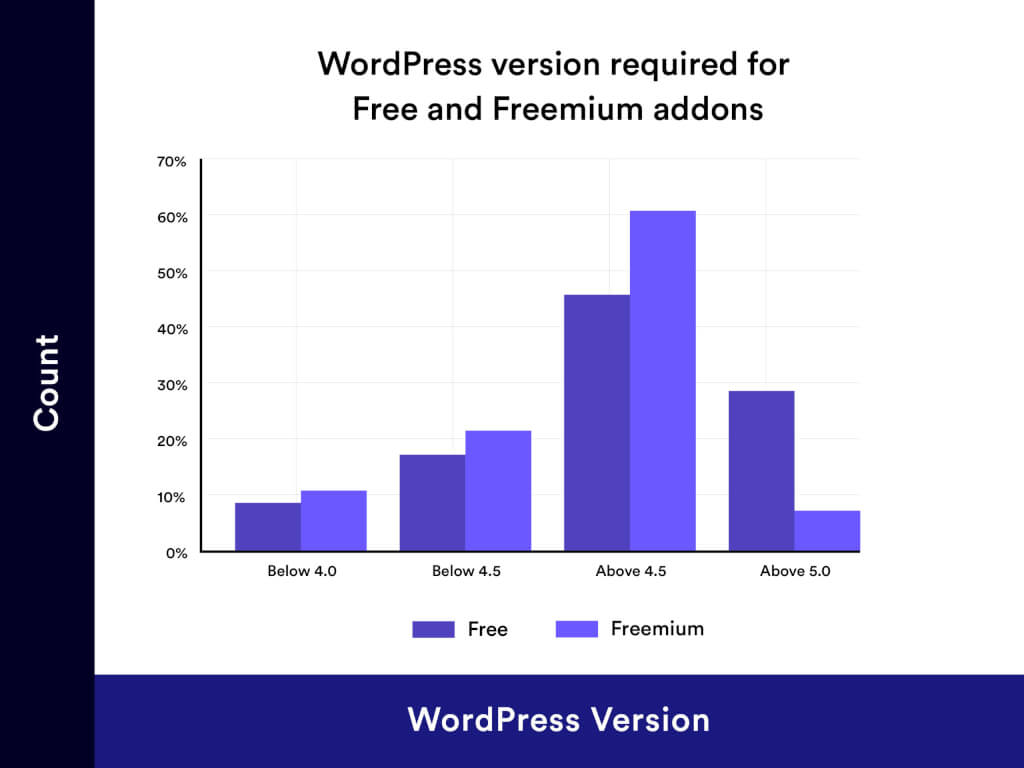
On the other hand, a very small percentage of freemium add-ons requires WordPress version 5.0 or above.
Key Takeaway: The majority of add-ons downloaded from the WordPress repository work with WordPress version 4.5 or above.
Paid Add-ons Dominate The Elementor Market
Considering that there are so many freemium add-ons in the market, we were surprised to find that paid add-ons actually dominate the Elementor market.
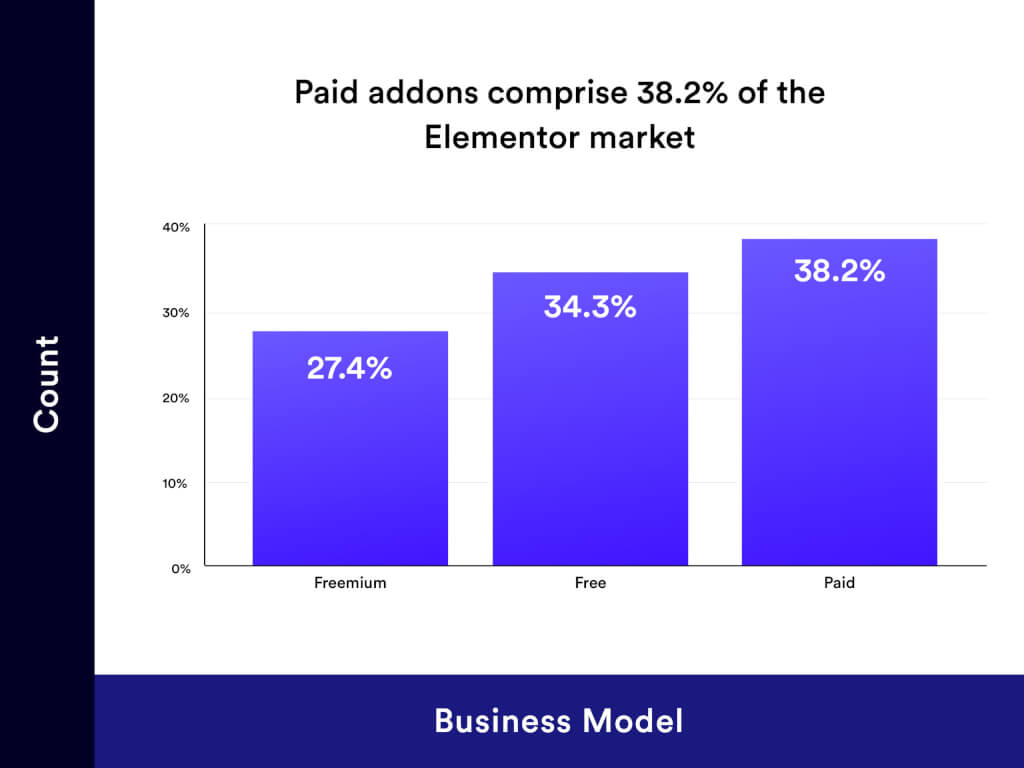
Of course, this data is only based on our sample set and if we were to analyze all the free add-ons, the data would be a bit different.
Among paid and freemium add-ons, the lifetime plan is more popular than the annual plan. 76.1% of add-ons have a lifetime plan while only 56.7% of add-ons have an annual plan.
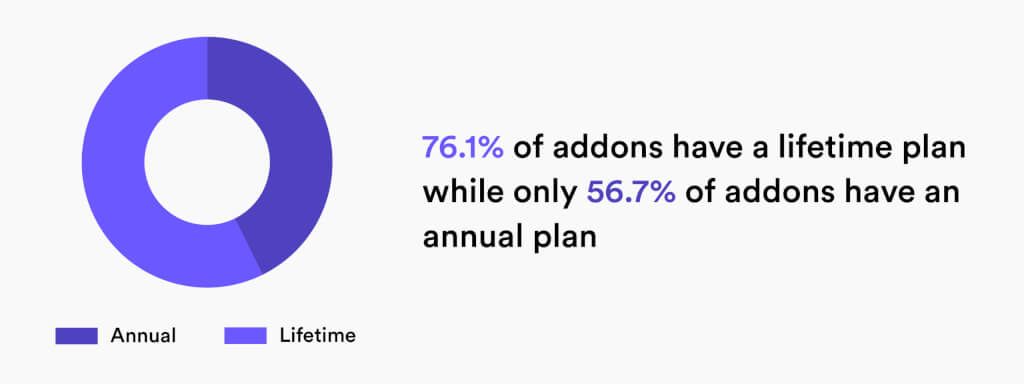
This data is key for users who prefer purchasing a lifetime plan of plugins.
Key Takeaway: Paid add-ons dominate the Elementor market with the lifetime plan being more popular than annual plans.
The Average Pricing A Single-Site Annual Plan Of An Elementor Add-on Is $26.4
When it comes to pricing, Elementor add-ons cost $26.4 annually on average for a single-site plan.

We also found that a single-site lifetime plan costs 71.59% more than the annual plan. The average cost of a single-site lifetime plan is $45.3.
The most surprising insight is that freemium add-ons actually cost more than paid add-ons. We noticed that this trend is consistent regardless of annual or lifetime plans.
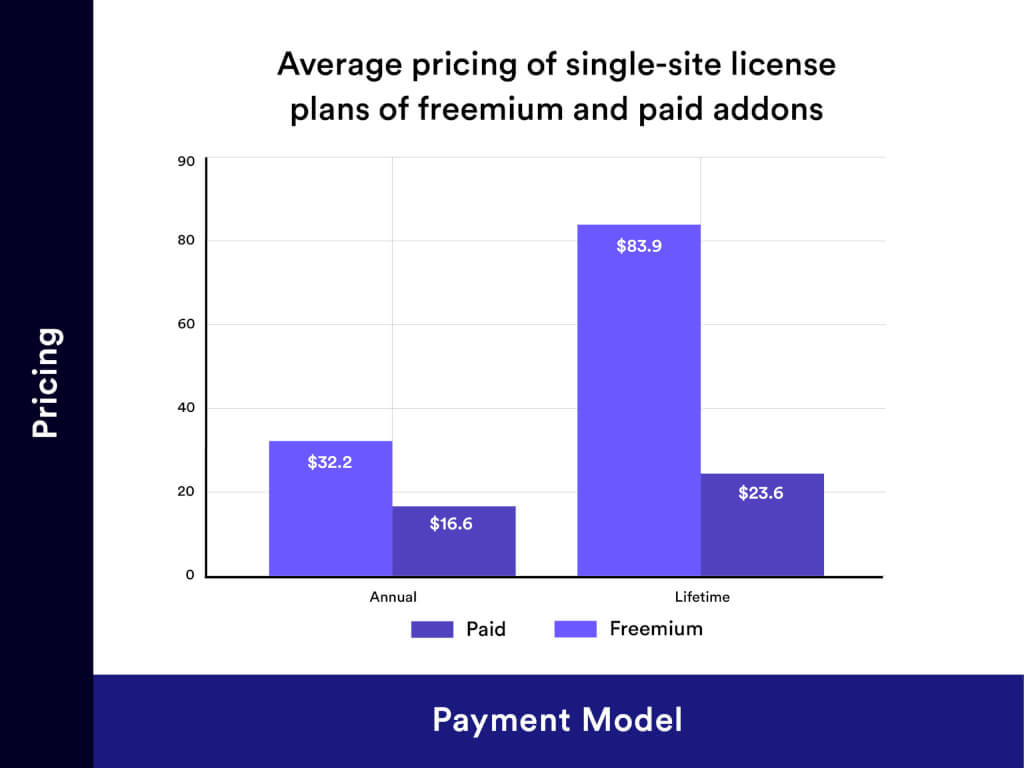
We compared single-site plans of both paid and freemium add-ons and noticed that annual plans of freemium add-ons cost 93.98% more than the annual plans of paid add-ons.
Moreover, the lifetime plans of freemium add-ons cost 255.51% more than the lifetime plans of paid add-ons.
The biggest reason for such a big difference is that freemium add-ons have a bigger widget offering than paid add-ons.
After analyzing the pricing of single-site plans, we went ahead to see how the pricing changes for 1000 or unlimited site plans which are usually the highest pricing plans in many add-ons.
We found that the average annual pricing of the 1000/unlimited site plans is $84.3.

The average lifetime pricing for the same plan is $310.5 which is an increase of 268.33%.
The same trend played out when we compared the pricing of freemium add-ons with paid add-ons.
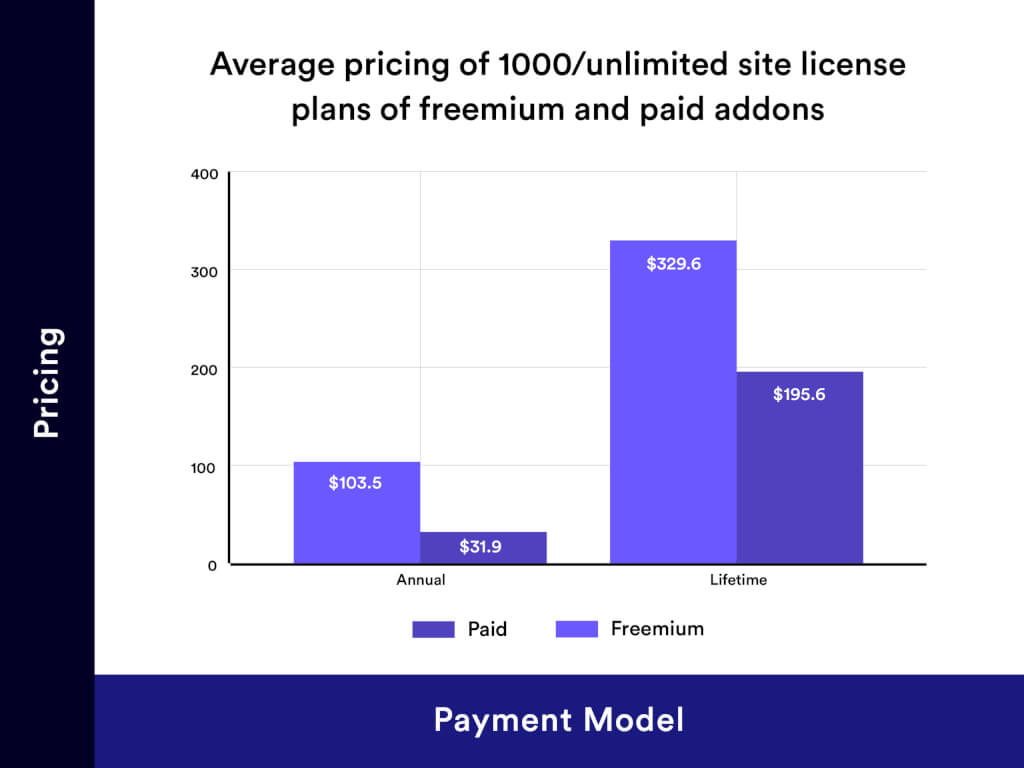
Key Takeaway: Both annual and lifetime plans of freemium add-ons are priced higher than paid add-ons.
53.7% Of Elementor Add-ons Offer An Unlimited Sites License
Lastly, we analyzed the site usage classification to find the most popular site plans among add-ons.
In our study, we found that 94% of add-ons offer a single-site license and 53.7% of add-ons have an unlimited site license.
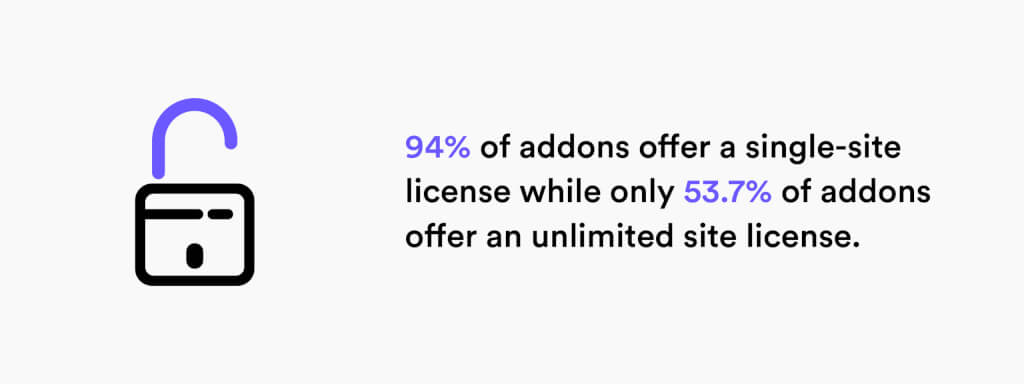
We also looked at how the site usage differs between paid and freemium add-ons. Our data showed that the unlimited site license is more popular among freemium add-ons.
Only 35.8% of paid add-ons offer an unlimited site license while 78.5% of freemium add-ons have an unlimited site license plan.
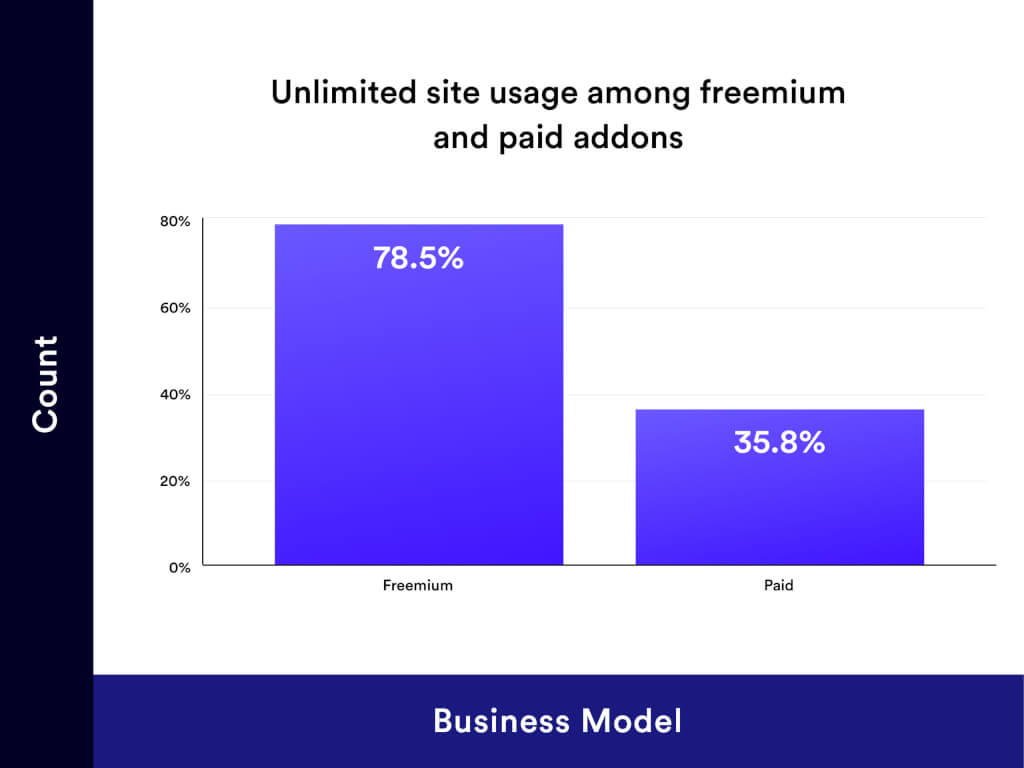
Lastly, according to our data, the 3, 5, 25, and 100 site licenses are not very popular.
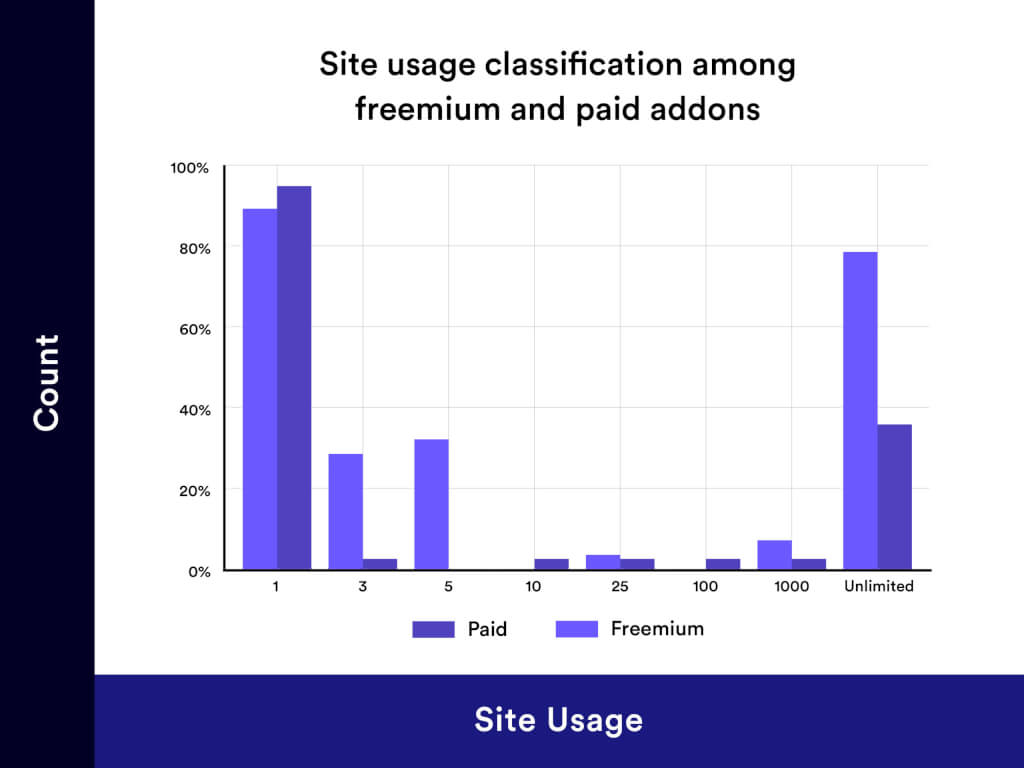
Key Takeaway: The unlimited site license is very popular among freemium add-ons.
Conclusion
This data study helped me a lot to learn more about the Elementor add-ons market. I hope this study helps you too.
Now, I’d like to ask you a question:
What Elementor add-ons do you use on your website?
Let me know in the comments section below.
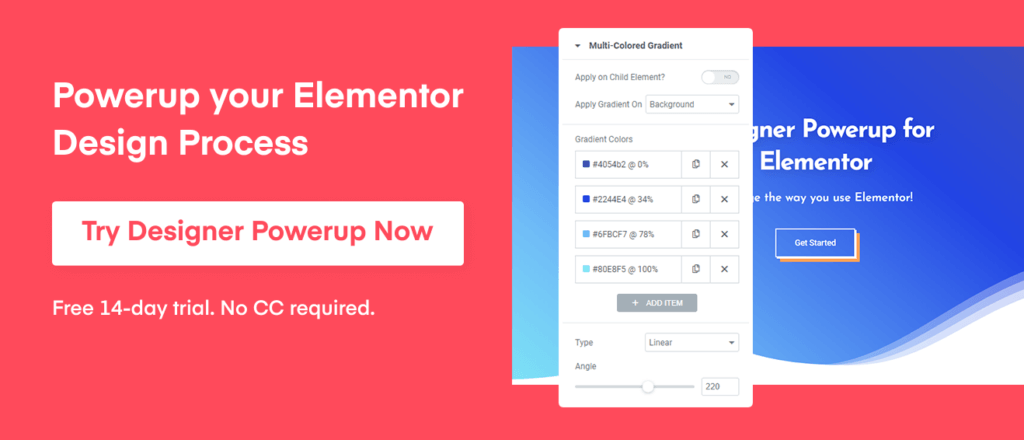

9 Responses
This is an incredibly thorough analysis of the Elementor Plugin Market.
Great job, Ahfaz!
Thanks a lot, Josen! 🙂
Good article!
Thank you! 🙂
Wow! The structure of this blog and the images are truly amazing! What are the best free add-ons according to you except the Essential one?
It really depends on what widgets or features do you need while building a website. If an add-on has that widget, I’d simply choose it regardless of how popular it is.
Thanks for this great analysis
Fantastic study made here. The only (for me important) thing missing here is which plugins are most proper coded and not only bloating and slowing dowm the system.
Hi Ahfaz Ahmed, Great knowledge shared briefly about the Elementor plugin. I used this plugin on other blogs for some time it was good.